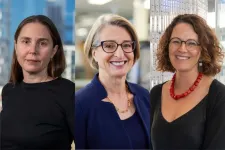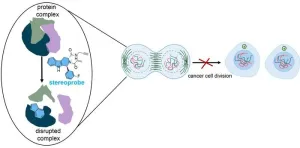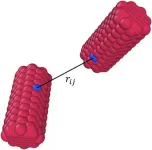(Press-News.org) Three distinct problems in data science — trend identification in graphs, the quantitative study of scientific literature and evaluation of single-cell genomics — will all be addressed by new research in large-scale network analytics, jointly led by Distinguished Professor David Bader at New Jersey Institute of Technology.
The problems have a common challenge of finding patterns, known as community detection, from inside incredibly large datasets. Work is funded by a $648,000 National Science Foundation grant, Cyber-Infrastructure for Community Detection, Extraction, and Search in Large Networks. Bader is a principal investigator, receiving $250,000 for research. He is working with George Chacko and Tandy Warnow, both of University of Illinois Urbana-Champaign.
What will happen now is the development of new algorithms to identify clusters within those graphs. Bader’s role is scalability and performance. He brings Arachne to the table, which is open-source software that he and colleagues have worked on since 2022, designed to organize graphs with trillions of vertices and edges while presenting a Python interface that almost anyone can learn. Chacko is working on project benchmarking and Warnow is developing new algorithms and interoperability with other methods.
They are planning to test the new method for various applications. In one field, single-cell genomics, it will involve “clustering very large networks whose vertices represent cells and where the weight of an edge between two vertices is computed based on gene expression profiles,” the team explained.
But it’s scientometrics that has Bader most excited. This is a meta-field where researchers study how to mathematically evaluate the impact of papers and citations.
“A lot of information can be learned by looking at the metadata of published literature,” said Bader, director of NJIT’s Institute for Data Science. “For instance, looking at which papers cite others, which authors co-published together, and so on. And when there are questions emerging, like who are the experts on the following topic, or what are the papers I need to read to really get an understanding of a particular field, that's where scientometrics comes into play.”
“Right now, the data sets for scientometrics are very, very large in size, and current tools, for instance, NetworkX in Python, or other such packages, don't scale to the size problems needed by the scientometrics community. So what this grant is enabling is new algorithms and new implementations that are scalable to be able to solve their problems. And so this is where we're going to pick up Arkouda and Arachne to work on them,” he noted, referring to his own prior research.
So far, “There are prototypes for some of the algorithms that [Warnow] has developed, and they work on small test cases. So the idea is, we essentially have a proof of concept, but there's sequential implementations, there's slow implementations and our challenge is going to be able to get them to scale to the problem sizes that the scientometrics community needs for their data sets, and to be able to make it run fast.”
END
NJIT and Illinois research on data analytics will measure impact of scientific literature
2024-08-26
ELSE PRESS RELEASES FROM THIS DATE:
UCLA receives $1 million NSF grant to accelerate commercialization of quantum technologies
2024-08-26
Researchers from the California NanoSystems Institute at UCLA and their colleagues have received a one-year, $1 million grant as part of a new National Science Foundation program aimed at accelerating the development and commercialization of quantum technologies for the benefit of society.
The Quantum Sensing and Imaging Lab, or Q-SAIL, which will be led by UCLA quantum physicist David Leibrandt, is one of five pilot projects across the country selected by the NSF to participate in the agency’s new National Quantum Virtual Laboratory, a first-of-its-kind national resource to enable the faster ...
3D shapes of viral proteins point to previously unknown roles
2024-08-26
SAN FRANCISCO—Viruses are tricky to keep up with. They evolve quickly and regularly develop new proteins that help them infect their hosts.
These rapid shifts mean that researchers are still trying to understand a multitude of viral proteins and precisely how they increase viruses’ infecting abilities—knowledge that could be crucial for developing new or better virus-fighting treatments.
Now, a team of scientists at Gladstone Institutes and the Innovative Genomics Institute led by Jennifer Doudna, PhD, have harnessed computational tools to predict the three-dimensional shapes of nearly 70,000 viral ...
UVA's first-ever data science majors begin their journey
2024-08-26
A new era at the University of Virginia’s School of Data Science officially kicked off, as the inaugural class of data science undergraduate majors arrived for orientation on the eve of UVA’s first day of classes.
Throughout the day at the new School of Data Science building, students heard from faculty and staff, learned more about their curriculum, took headshots and a group photograph, and began to familiarize themselves with classrooms and other features of the facility that would be their academic home.
The day also served as a call to action, as students learned not only what requirements would be needed to complete their degree but what a data ...
High BMI eligibility for semaglutide could cost Medicare an additional $145 billion annually
2024-08-26
Embargoed for release until 5:00 p.m. ET on 26 August 2024
Annals of Internal Medicine Tip Sheet
@Annalsofim
Below please find summaries of new articles that will be published in the next issue of Annals of Internal Medicine. The summaries are not intended to substitute for the full articles as a source of information. This information is under strict embargo and by taking it into possession, media representatives are committing to the terms of the embargo not only on their own behalf, but also on behalf of the organization they represent.
----------------------------
1. High ...
Brigham-led study estimates 1 in 7 Medicare beneficiaries with high body mass index may qualify for anti-obesity drug
2024-08-26
If Medicare Part D narrowly defines cardiovascular disease, majority of patients would remain ineligible while new federal spending could still exceed $10 billion
Current federal regulation restricts Medicare from covering drugs prescribed solely for weight loss. However, in March 2024, Medicare announced it would extend coverage to semaglutide (Wegovy), a popular glucagon-like peptide-1 receptor agonist (GLP-1RA), for patients with elevated body mass index (BMI) who also had established cardiovascular disease (CVD). This means that the definition of “established CVD,” which has not been ...
$66 million in 10 years: Groundbreaking strategic investment fund to drive biomedical innovation in Australia
2024-08-26
With a grand vision of investing $66 million over 10 years in groundbreaking medical innovations, WEHI’s first strategic investment fund, 66ten, is the largest internal pre-seed and seed fund created by an Australian medical research institute.
Managed by WEHI Ventures, 66ten serves the sole purpose of bridging the gap between scientific discoveries and commercial viability, ultimately creating both positive outcomes for patients and healthcare systems globally as well as financial returns to investors.
Since its foundation a year ago, 66ten has ...
New way to potentially slow cancer growth
2024-08-26
LA JOLLA, CA—Fighting cancer effectively often involves stopping cancer cells from multiplying, which requires understanding proteins that the cells rely on to survive. Protein profiling plays a critical role in this process by helping researchers identify proteins—and their specific parts—that future drugs should target. But when used on their own, past approaches haven’t been detailed enough to spotlight all potential protein targets, leading to some being missed.
Now, by combining two methods of protein analysis, a team of chemists at Scripps Research has mapped more than 300 small molecule-reactive ...
Using machine learning to speed up simulations of irregularly shaped particles
2024-08-26
Simulating particles is a relatively simple task when those particles are spherical. In the real world, however, most particles are not perfect spheres but take on irregular and varying shapes and sizes. Simulating these particles becomes a much more challenging and time-consuming task.
The ability to simulate particles is critical to understanding how they behave. For example, microplastics are a new form of pollution as plastic waste has increased drastically and uncontrollably decays in the environment ...
Ochsner Digital Medicine teams up with AmeriHealth Caritas Louisiana to improve treatment of hypertension, Type 2 diabetes
2024-08-26
New Orleans, LA. – Ochsner Digital Medicine has teamed up with AmeriHealth Caritas Louisiana to offer digital medicine services to the health plan’s members. Utilizing remote patient management (RPM), Ochsner Digital Medicine and AmeriHealth Caritas Louisiana will work together to help members with certain chronic conditions better manage their health and improve their quality of life.
AmeriHealth Caritas Louisiana, part of the AmeriHealth Caritas Family of Companies, is a Healthy Louisiana managed Medicaid health plan covering ...
Closing the RNA loop holds promise for more stable, effective RNA therapies
2024-08-26
New methods to shape RNA molecules into circles could lead to more effective and long-lasting therapies, shows a study by researchers at the University of California San Diego. The advance holds promise for a range of diseases, offering a more enduring alternative to existing RNA therapies, which often suffer from short-lived effectiveness in the body.
The work was published Aug. 26 in Nature Biomedical Engineering.
RNA molecules have emerged as powerful tools in modern medicine. They can silence ...





